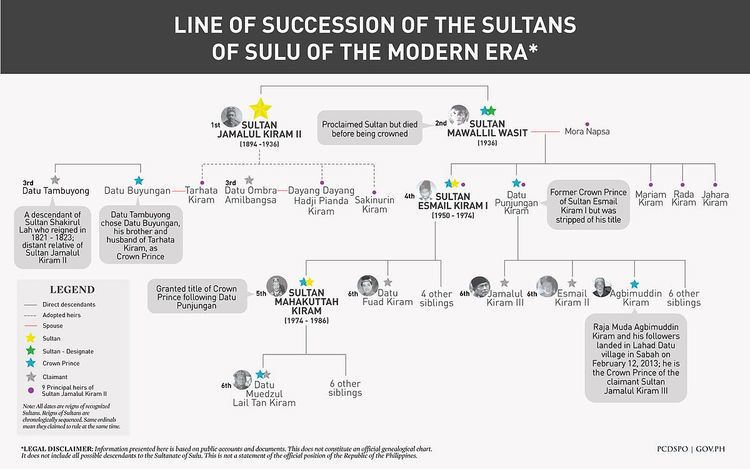Abolition 1986 | Residence Datu Sangahan, Sulu | |
 | ||
First monarch Rajah and Sharif ul-Hāshim Last monarch Mohammed Mahakuttah A. Kiram
(last recognised Sultan) Formation 1390
(Sultanate of Sulu was said to be founded on 1405) Pretender(s) Muedzul Lail Tan Kiram
Full list
Muwallil Wasit II
Esmail Kiram I
Mahakuttah Kiram
Aguimuddin Abirin
Jamalul Kiram III
Mohammad Akijal Atti
Ismael Kiram II
Phudgal Kiram
Muedzul Lail Tan Kiram
Fuad Kiram
Mohamad Akjan Ali Muhammad
Abdul Rajak Aliuddin
Eddy T. Sulaiman | ||
This is a list of the rulers of the Sultanate of Sulu. The Royal House of Sulu is a Muslim royal house of the Sulu Archipelago in the Philippines.
Contents
Pre-sultanate kings
Sulu was divided into three Kingdoms before the Sultanate arose.
The descendants of Paduka Pahala, through his two sons, live in Dezhou in China have the surnames An and Wen.
The Hashemite Sharif ul-Hāshim of Sulu arrived in Sulu and married Princess Dayang-dayang Paramisuli from the previous royal family, founding the Sulu Sultanate.
List of sultans from 1405 to 1936
The following list details the holders of the title of sultan between 1405 and 1936.
List of Sultans from 1936 to 1950
The political sovereignty of the Sultanate was abolished in 1915. However non-sovereign powers such as the right to confer titles—as well as cultural, proprietary, and religious authority—remained. The descendants of the royal family are still recognised and honoured as de facto royalty by the people in Sulu and by others..
After the death of Sultan Jamalul-Kiram II in 1936, the Philippine Government, the successors in sovereignty to the United States of America, decided not to recognise the continued existence of the Sulu sultanate, according to a letter to the Governor of North Borneo dated 28 July 1936, from His Britannic Majesty's Consul General in Manila. After that decision several legitimate claimants and pretenders to the throne of Sulu appeared. During World War II, Japanese and American forces exerted influence in Sultanates affairs, each recognising a pretender supportive of their agenda.
List of Sultans from 1950 to 1986
In 1962, the Philippine government of President Diosdado Macapagal officially recognised the continued existence of the Royal Sultanate of Sulu, and, on 24 May 1974, officially recognised Sultan Mohammad Mahakuttah Kiram (reigned 1974–1986), under Memo Order 427, which was issued by Philippine President Ferdinand Marcos, and which stated that "The Government has always recognised the Sultanate of Sulu as the legitimate claimant to the historical territories of the Republic of Philippines" and that Mahakuttah A. Kiram is officially recognised as the Sultan of Sulu with the government being obligated to support his coronation on that date, his 8-year-old eldest son, Muedzul Lail Tan Kiram, being crowned beside his father as Raja Muda (Crown Prince). On 16 February 1986, Muedzul Lail Tan Kiram, succeeded his father to become the Head of the Royal House of Sulu. As the eldest son of the former Sultan Mahakuttah, he is the legitimate heir to the throne of the Sultanate of Sulu.
The following list details the holders of the title Sultan between 1950 and 1986, who are officially recognised by the Philippine Government.
List of Self-proclaimed Sultans from 1980 to 2013, as recognised by the Provincial Government of Sulu
After the death of Sultan Mahakuttah A. Kiram, the Philippine national government failed to formally recognise a new Sultan. Mahakutta's Crown Prince Muedzul Lail Kiram, the heir to the throne according to the line of succession as recognised by the Philippine governments from 1915 to 1986, was 20 years old upon his father's death. Due to his young age, he failed to claim the throne at a time of political instability in the Philippines that led to peaceful revolution and the subsequent removal of President Marcos. The gap in the sultanate leadership was filled by crown claimants from rival branches. Therefore, the following Sultans were not crowned with the support of, nor received formal recognition from, the Philippine government as their predecessors had until 1986. However, the Philippine national government decided to deal with one or more of these claimants regarding issues concerning the sultanate's affairs.
The current legitimate claimant
These are the current claimants.
